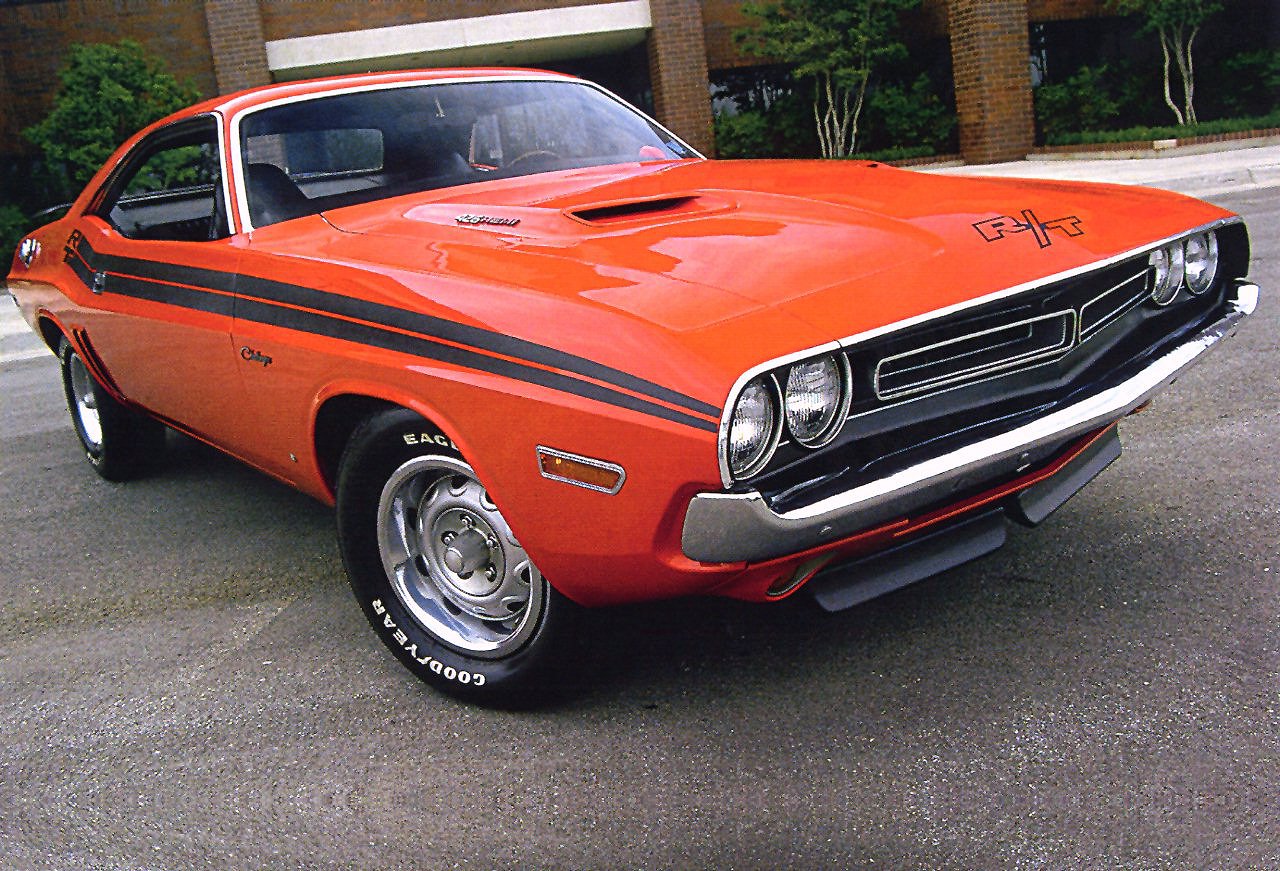1971 Dodge Challenger R/T
1968 The first of the Dodge Challenger prototypes is produced.
1969 The Dodge Challenger is officially released to the public as a 1970 model on Friday, August 1, 1969.
1970 The first model year. In coming with Dodge's market position of competing with Pontiac and Mercury, the Challenger's wheelbase is 2" longer than its Plymouth cousin, the Barracuda. The Challanger was offered in five different trim lines (Deputy, base, R/T, SE and T/A) 1970 and several engine options were available, ranging from the 225 CID "Slant Six" to the 426 cubic inch Hemi. There were variations of the 340, 383, and 440 CID engines in between. Almost 73,000 units were sold that first year.
1971 Dodge Challenger R/T
1970 In order to race in the Sports Car Club of America's Trans American Sedan Championship, Dodge built a street version of its race car called the Dodge Challenger T/A. Although the race carsran a destroked version of the 340, street versions took the 340 and added a trio of two-barrel carbs atop an Edelbrock aluminum intake manifold, creating the 340 Six Pack, rated at 290 hp. The engine breathed air through a suitcase-sized air scoop molded into the pinned down, lift off matte-black fiberglass hood. Dual exhausts ran to the stock muffler location under the trunk, then reversed direction to exit in chrome tipped "megaphone" outlets in front of the rear wheels. The T/A was the first production car to use different size tires front and rear: E60x15 in the front and G60x15 in back. Bold stripes, 340 Six Pak graphics and a ducktail spoiler added to the package. The T/A would only be available for 1970 as Dodge would pull out of Trans Am racing.
1971 Revised grille and taillights differentiate the '71 from the '70. The T/A option is dropped, but a base model convertible is offered, as well as 50 "Indianapolis 500 Pace Car" models. The R/T model is now available with the 340. Sales slumped from 1970, with roughly 30,000 units sold.
1971 Dodge Challenger R/T
1971 The Dodge Challenger makes its film debut in the movie "Vanishing Point". In the film, our man Kowalski works for a car delivery service and bets that he can deliver a white 1970 Dodge Challenger R/T from Denver to San Francisco in 15 hours. After run-ins with motorcycle cops and highway patrol they chase him through Utah, Nevada and California. Along the way, Kowalski is guided by Super Soul - a blind disc jockey monitoring a police radio scanner. Throw in lots of chase scenes, gay hitchhikers, and a naked woman riding a motorbike and you've got a great cult hit from the early 70's.
1972 Big changes in 1972. Gone were the R/T, SE and convertible models and all big block engines, incluidng the Hemi. Another new grille (the third in three years), the "fish mouth" (“sad faced”) grille. The Challenger Rallye was introduced to replace the R/T and it came with the (now 240 hp) 340. Base engine was the "Slant Six" and optional was the 318 2-bbl with 150 hp. Production was down to just over 26,000 units.
1971 Dodge Challenger R/T+
1973 1973 brought large bumper guards and the "Slant Six" was dropped from the lineup. Base engine was now the 318 2-bbl with 150 hp. A gunmetal grey color was added and the 360 4-bbl (245 hp net) was introduced late in the year to replace the 340, which was difficult to certify for emissions. Production rose to nearly 33,000.
1974 By 1974, there were two engine choices: the 318 and the 245 hp 360. Larger bumper guards were installed to meet increasing crash standards. Challenger production ended in April, 1974, with a mere 16,000 units produced. In its short life, the Challenger turned out to be one of the best-looking pony cars and is today highly sought after. Its sales were probably never satisfying for Chrysler, which had invested quite a bit in the Challenger and Barracuda.
1978 The Challenger nameplate was resurrected on a re-badged Mitsubishi Galant Lambda, an "economy sport" car paired with the Plymouth Sapporro in United States. Offered with 1.6L or 2.6L inline four cylinder engines, the car was priced right around $8,000. It was a far cry from the original with its tiny engines and distinctly "import" styling.




